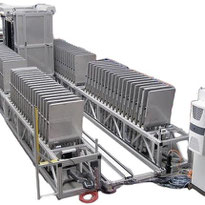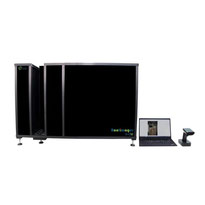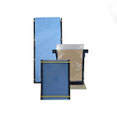Rhizobox Imaging Systems
Automated Rhizobox Imaging Platform

- Automated Rhizobox Imaging. In partnership with an established automation company (Germany), we provide a fully automated, modular rhizobox imaging system to root research institutions worldwide. We can apply open source imaging routines (e.g. as in the Shoot Phenobox), involve other companies to realize complex imaging tasks above (shoot) and below (roots in rhizobox) ground, or customers can realize the imaging system according to custom specifications. Show more
-
The Rhizobox Imaging platform consists of fixed racks with storage bays for 50 or 100 Rhizoboxes each. The cost-effective system is designed to start with one rack; the capacity (e.g. to 200 or more rhizoboxes) can be extended as needed either as a low-cost fixed-position system or mobile rack units (using autonomous carrier systems) for large-scale phenotyping facilities. In short, a central imaging chamber is moved along the rhizobox racks; boxes are automatically and individually transferred into the chamber for scheduled imaging above and below ground. QR code or location (i.e. storage bay number) based systems can be implemented for image registration. The imaging chamber is up to 250 cm higher than the rhizobox to accommodate even large shoots (corn, sugar cane, trees, etc.); automatic gates on both sides with rolling shutters are used to exclude light. Weighing (load cells) and automatic irrigation systems (per treatment or per individual rhizobox) can be implemented as options. Rhizoboxes remain fully accessible from the walkways for easy maintenance, individual measurements and loading of rhizoboxes (individually or in units of 5 boxes each); rack height is ~50-80 cm for ergonomic working conditions. When not in use, the imaging chamber is "parked" outside the rack area (preferably to the north) to avoid creating environmental gradients. Rhizobox dimensions are freely factory configurable with the option to modify the system (e.g. rhizobox size) later if required. Service packages are available to ensure decades of operation, e.g. with local partner companies in several countries including the USA.
Due to the significant planning involved in such a root research infrastructure project, please contact us early in the project development phase to discuss your goals, budget, time-line and available infrastructure (greenhouse size, electricity, etc.).
LK-1250 Semi-Automatic Rhizobox Imager

Eco-mind LK-1250 Rhizobox Imager, designed for semi-automatic digital imaging of the transparent surfaces of individual rhizoboxes for subsequent image analyses. The imaging system uses a 20 MP CMOS sensor and LED with adjustable brightness. The resolution, area and distance of the camera equipment are set at the factory so that the system is ready to be used directly with A4 (letter) or custom sized rhizoboxes to obtain complete, clear and reflection-free root system images. A barcode scanner allows easy and automated registration of individual rhizoboxes with the imaging software. For a quote, please indicate the desired Rhizobox size; the standard size is A4/letter (outside dimensions) and/or get in contact.
Imaging of Growth Pouches
The LK-1250 rhizobox imager can be fitted with matching adapter cassette to image soil-free, high-throughput growth pouch and root phenobox phenotyping systems. The insets will provide a sliding system to rapidly enter and image roots on hanging (e.g. PhenoRacks) or rigid germination paper systems.
Application Potential of Automatic Rhizobox Imaging Systems
- Automated imaging of roots and the rhizosphere in ex situ rhizoboxes is emerging as a valuable tool in root research and in breeding crops that are better able to grow under stress conditions. By using automated imaging techniques, researchers can gain a better temporal resolution of root architecture development and root-soil interactions, and thus the dynamics of water & nutrient uptake - ultimately leading to the development of stress-tolerant crop varieties and a better understanding of root and rhizosphere functioning.. Continue reading
-
Traditionally, the study of roots and the rhizosphere has been challenging due to their complex and hidden nature below the soil surface. However, recent advances in imaging technologies and computer vision algorithms started to revolutionize root research. Rhizoboxes, controlled environments where plants can be grown while their roots are easily accessible for imaging, provide an ideal platform for studying root development and interactions with the surrounding soil. Automated imaging systems, permantantly installed next to these rhizoboxes ("RhizoPot Scanner Systems") or suited to rapidly image large numbers of individual Rhizoboxes, capture high-resolution images of roots and the rhizosphere at multiple time points, allowing researchers to track and analyze root growth patterns, root architecture, and responses to various stresses at unprecedented replication and frequency. One of the key advantages of automated imaging in Rhizoboxes is thus the ability to capture larger data sets at a high temporal resolution. Traditional, manual imaging methods are labor-intensive and time-consuming, limiting the scope and scale of rhizobox studies. With automated imaging systems, researchers can collect a wealth of data on root development and turnover, allowing detailed analysis and identification of key traits associated with stress tolerance at appropriate replication. By analyzing the captured images, researchers can quantify root length, surface area, branching patterns, and root architecture parameters over time, which are important determinants of nutrient and water uptake efficiency. These data help breeders understand how different genotypes respond to stress and identify root traits that contribute to improved stress tolerance. Through selective breeding and genetic manipulation, crops with desirable root traits can be developed, leading to improved yields and resilience in challenging environments.

In summary, automated imaging of rhizoboxes, ideally combined with simultaneous shoot phenotyping, offers significant advantages for plant research, including the breeding of stress tolerant crops. It provides a non-invasive and high-throughput approach to study root growth dynamics, root architecture, and root-soil and root-microbiome interactions under controlled conditions ex situ. In addition, high-frequency imaging of the rhizosphere helps to unravel the complex interactions between abiotic factors (soil moisture, temperature, diurnal and seasonal cycles, irrigation events) and roots, soil and microorganisms, especially when combined with other analyses (exudates, uptake rates, etc.) in rhizosphere boxes and canopy phenotyping. Finally, the more standardized acquisition of rhizobox images (similar colour and illumination schemes, hue, etc.) is expected to facilitate the development/application of deep learning algorithms for automated analysis of root and rhizosphere characteristics.
RhizoPot Scanner Systems are a compromise between rhizoboxes with automatic image acquisition and mesoscosm studies.
Consider Rhizotrons and Root-windows for educative displays, as mesocosms and/or for large-scale ex situ or field-based observation/experimentation on roots and soil.









